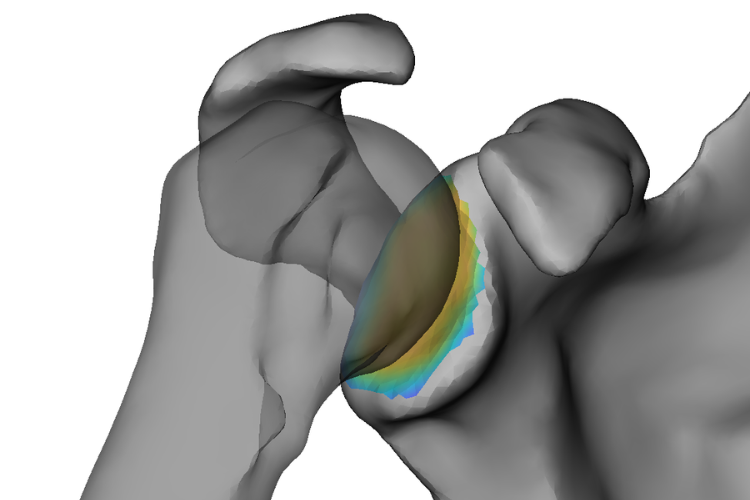Erin Lee, a fifth-year Mechanical and Materials Engineering PhD student studying shoulder biomechanics in the Skeletal Observation Lab, has published an interdisciplinary and collaborative research paper in the internationally renowned Proceedings of the Royal Society B journal as first author!
This paper, “A comparative approach for characterizing the relationship among morphology, range-of-motion and locomotor behaviour in the primate shoulder” addresses a crucial gap in our understanding of the development of shoulder function and movement. Historically, anthropologists have compared bone shapes across primate species and observed their behaviour in the wild to infer how shoulder shape influences motion. Lee developed a contact-based computational model to directly test how bone shape contributes to 3D range-of-motion across primate species.
Lee summarized the results of her four years of research: “We found that compared to our most closely related species (chimpanzees and gorillas), humans have highly mobile shoulder shapes, suggesting our shoulders may have evolved for activities requiring high mobility such as throwing and tool use. We also found that many of the shape features assumed to be important by anthropologists did not contribute to shoulder mobility. Instead, we identified new 3D shape features that better predict range-of-motion.”

Photo caption (above): a CT scan of a human shoulder joint used in Erin Lee's research.
Lee’s team also applied their model to a 2-million-year-old fossil hominin, Australopithecus sediba, demonstrating the ability to reconstruct function in extinct species for which we only have skeletal remains. More broadly, this work provides evolutionary context to assist in the human-health aspect of Lee’s PhD research – understanding why certain shape features are associated with injuries in present-day human shoulders.
This research was intentionally and importantly collaborative, resulting in broader insights and a more holistic understanding of shoulder function. Collaborator and co-author, Dr. Nathan Young, is an evolutionary and developmental biologist who pioneered approaches to understanding how the shoulder has changed shape over evolutionary time. Lee explained the impact of Dr. Young’s collaboration with her research, “Dr. Young provided a perspective that allows us to consider primate shoulder shape-function relationships more holistically. For example, as engineers, it can sometimes be tempting to assume that bone shape arises mainly from evolutionary selection on mechanical demands. However, Dr. Young helped us consider other important factors that contribute to shape, such as developmental constraints, genetic constraints, and environmental implications. Personally, I feel that Dr. Young’s guidance and input have taught me to think holistically and value diverse perspectives.”
This collaboration was facilitated by Lee’s supervisor, Dr. Rainbow, who is the senior author of this paper. Dr. Rainbow reiterated that this research was interdisciplinary from the onset, “We teamed up to see if we could develop approaches that incorporate functional analyses into the evolutionary framework. In other words, we were interested in seeing if we could use engineering approaches to learn how the shape changes [that Dr. Young] identified would change how the shoulder moves and produces forces.” The impact of the team’s research is not limited to academia or improved theoretical understanding, Dr. Rainbow explained, “This work is important because it can provide insights into primate and human evolution and may provide insights into human health.”

Photo caption (above): Erin Lee and the team of researchers with Dr. Rainbow's Skeletal Observation Lab in one of the research labs at Hotel Dieu Hospital.
Lee described how Dr. Rainbow’s guidance and expertise through her research have been extremely valuable. In particular, he was key to fostering productive critical thinking across knowledge systems. Lee explained, “Dr. Rainbow has a unique ability to connect the dots between concepts that appear seemingly unrelated at first glance. The shoulder is highly complex and relatively understudied compared to other musculoskeletal joints. Dr. Rainbow helped identify that bridging what we know from evolutionary biology, medicine, and biomedical engineering ultimately helps us unravel its complexity.”
Working across disciplines can be challenging as researchers come with their own expectations, assumptions, and methodologies. However, Lee, Dr. Rainbow, and Dr. Young demonstrate the value of interdisciplinary research in addressing gaps in knowledge, developing new, creative methods to answer complex questions, and providing greater opportunities for impact beyond academia.
Lee concluded, “Our work reflects how incredibly diverse engineering research can be. As a first-year student, I did not expect that I would eventually apply my engineering skills and knowledge to physical anthropology.” Now, as 5th year PhD student, Lee’s paper “A comparative approach for characterizing the relationship among morphology, range-of-motion and locomotor behaviour in the primate shoulder” is intentionally interdisciplinary with potential impacts on the fields of evolutionary biology, biomedical engineering, biology, medicine, and anthropology!